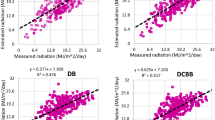Abstract
The RadEst 3.00 version software estimates total solar radiation using meteorological parameters such as precipitation, temperatures and solar radiation of Jumla (Lat. 29.27°N, Lon. 82.18°E, and Alt. 2514 m). The average temperature in Jumla varies between 12 to 30 °C and −11 to 12 °C at summer and winter respectively. The annual average precipitation is about 667–852 mm.The annual average daily global solar radiation is about 18.28 MJ/m2/day which is greater than at mid hill and low land region of Nepal. Radiation is calculated as the product of the atmospheric transmissivity of radiation and radiation outside earth atmosphere. The model parameters are fitted in two years data. The values estimated by the models are compared with measured solar radiation data. The performance of the model was evaluated using root mean square error (RMSE), mean bias error (MBE), Coefficient of Residual Mass (CRM) and coefficient of determination (R2). The RadEst 3.0 software which showed the better results using BC, CD, DB and DCBB, among them the BC model is the best model for this site. The values of RMSE, MBE, CRM and R2 are 2.16, 1.64, 0.00 and 0.79 respectively. The finding coefficients of these models can be utilized for the estimation of solar radiation at the similar meteorological sites of Nepal. The result confirms that there is strong correlation of global solar radiation with altitude and local weather condition.




Similar content being viewed by others
References
Bechini L, Duccob G, Donatelli M, Stein (2000) Agric Ecosyst Environ 81:29–42
Bristow KL, Campbell GS (1984) On the relationship between incoming solar radiation and daily maximum and minimum temperature. Agric For Meterol 31:159–166
Chegaar M, Lamri A, Chibani A (1998) Estimating global solar radiation using sunshine hours. P Energetique 1:7–11
Donatelli M, Bellocchi GS (1998) A simple model to estimate global solar radiation. In: Proceedings of the fifth congress of the European Society for Agronomy Nitra, Slovakia, vol II, pp 133–134
Donatelli M, Bellocchi GS (2001) Estimates of daily global solar radiation: new developments in the software RadEst3.00. In: Proceedings of International Symposium on modelling cropping System, 2nd edn, 16–18 2001. Institute for CNR, Florence, Italy, pp 213–214
Donatelli M, Bellocchi G, Fontana G (2003) RadEst 3.00 software to estimate daily Radiation data from commonly available meterological variables. Eur J Agron 18:363–367
IEA (2011) International Energy Assessment
Janjai S (2008) Assessment of solar energy potentials for Combodia
Kipp and Zonen (2006) CMP series instruction manual, Kipp and Zonen B.V., Delftech park 36, Netherlands
McVicar TR, Jupp DLB (1999) Agric For Meteorol 96:219–238
Poudyal KN (2015) Estimation of global solar radiation potential in Nepal. Doctoral thesis at IOE 2015. Institute of Engineering Central Campus Pulchowk Tribhuvan University, Kathamndu
Poudyal KN, Daponte P, De Vito L, Bhattarai BK, Sapkota B (2010) Proceedings of XVII IMEKO TC-4 international symposium, Kosice, Slovak report, 2010
UNFCO (2012) District profile Jumla. United Nations FieldCoordination, M.W.R, Nepalgunj
WECS (2010) Energy sector synopsis report, Kathmandu, Nepal
Acknowledgements
Authors are grateful to express thanks to Department of Hydrology and Meteorology Government of Nepal for providing the data of Pyranometer and other necessary supports. The support provided by the Prof. Dr. Indra B Karki, Dr. Rishi Ram Sharma, Prof. Debi P Bhattarai and all the faculty members of Department of Physics and staffs of Mahendra Multiple Campus Nepalgunj is highly acknowledged.
Author information
Authors and Affiliations
Corresponding author
Rights and permissions
About this article
Cite this article
Khatri Chhetri, B.R., Gurung, S. Estimation of total solar radiation using RadEst 3.00 software at Jumla, Nepal. Int J Syst Assur Eng Manag 8 (Suppl 2), 1527–1533 (2017). https://doi.org/10.1007/s13198-017-0625-5
Received:
Revised:
Published:
Issue Date:
DOI: https://doi.org/10.1007/s13198-017-0625-5




